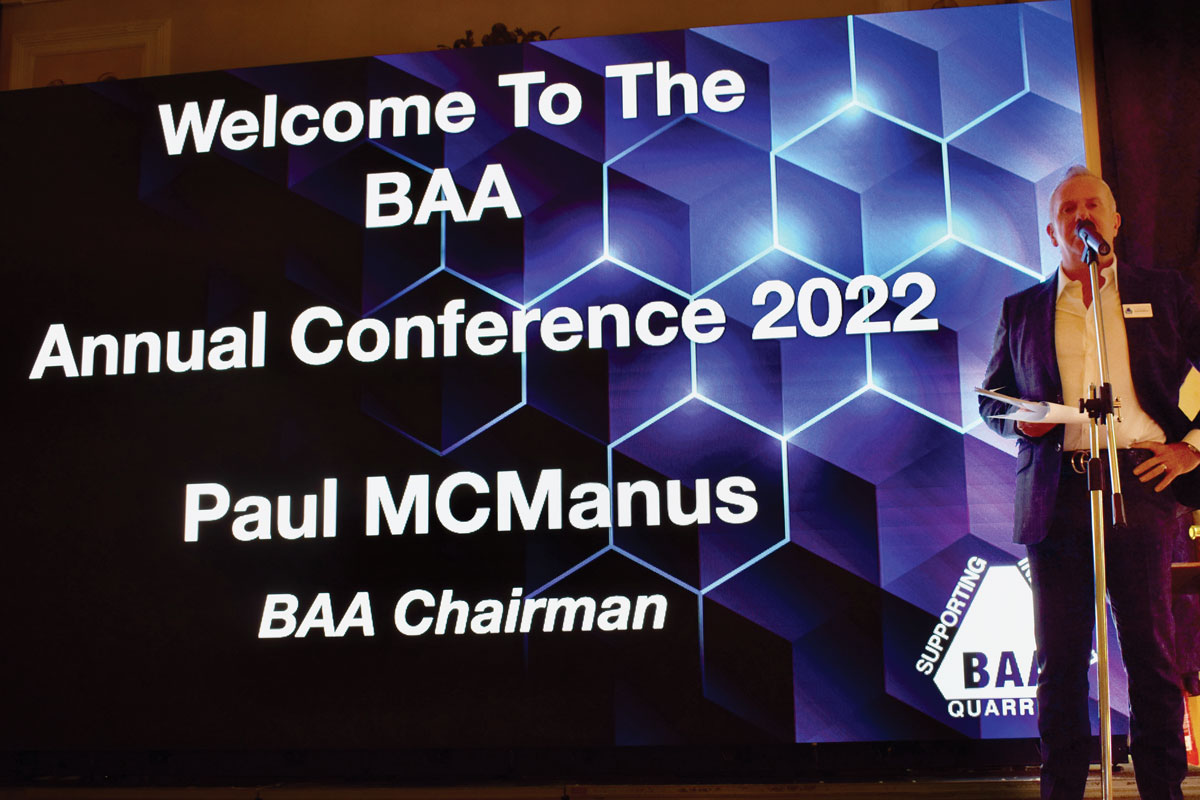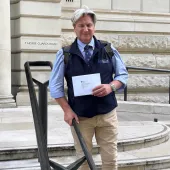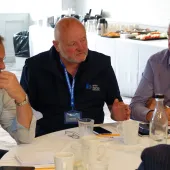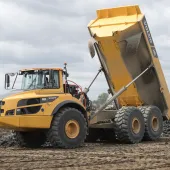BAA Annual Conference 2022: Part 2

First published in the August 2022 issue of Quarry Management
The second of two instalments on the proceedings of the British Aggregates Association’s annual conference at the Palace Hotel, Buxton
The key speaker during the afternoon session of the BAA Annual Conference 2022 was Lawrence Waterman OBE of the Park Health & Safety Partnership, who also chairs the Strategic Forum for Health and Safety in the Mineral Products Sector.
His impressive list of health and safety achievements and appointments include heading health and safety through all the stages of preparation, construction, operation, and handover of the facilities and infrastructure for the London 2012 Olympics and Paralympics, a programme of works that has been heralded as the healthiest and safest in UK history and continues to be a benchmark and inspiration to others.
The collaborative approach adopted for the Queen Elizabeth Olympic Park, which saw sub-contractors and supervisors respected and treated as a management team, meant the London Olympic Park was the first in the modern era where nobody died during its construction, which involved 85 million hours worked.
The first document the Olympics Delivery Authority (ODA) produced for the project was on health and safety and it included a declaration of intent that nobody would die. It was a declaration that government officials wanted removed until David Higgins, chief executive of the ODA, sent them a letter asking them if they were not committed to killing nobody, how many should they be committed to killing.
The original ‘no death’ declaration remained in place and now similar declarations appear on projects such as HS2 and Crossrail, and Mr Waterman said he saw no reason why quarries should not have the same declaration.
He said what it felt like to work on the Olympic Park site was a question of how the site was managed day to day, which is why there were training programmes and quarterly conventions for the supervisors. Their efficiencies carried on cranking up the quality of the health and safety management on the programme.
‘I think one of the lessons from 2012 was asking that challenging question: how do we establish the issue at every level in the organization, all the way to individual gangs of workers on site,’ said Mr Waterman.
‘There was not a lot of experimentation by the Olympics Delivery Authority, but rather it learnt from teams that were doing something well and leveraged it across the whole programme.’
The Safe Load Safe Road presentation during the morning session of the BAA conference (see previous issue of QM) had been an example, he said, of how the mineral products industry and the wider construction industry are good at learning from each other, rather than each making the same mistakes in turn, ‘and that’s why conferences like this are so useful’.
It is the aim of the Strategic Forum for Health and Safety in the Mineral Products Sector to learn from and support those in the industry, not to replace or duplicate what they are doing. The body meets twice a year to ‘discuss what’s going on in the sector, find out what people who are already leaders in the sector are doing, and to achieve a degree of agreement as to what the priorities are and how they ought to be co-ordinated’.
The first focus was on preventing entrapment, when people are caught in machinery and conveyor belts, following several incidents in 2017. It began by discussing what resources were required (booklets, posters, material on websites etc), who was in the best place to produce them, and who they should be circulated to and by.
QNJAC set up a task group to produce a standard showing what a good site should look like. It was given to HSE inspectors, so that whenever an inspector was going to visit a site, they would be using the same standard that the people running the quarry or plant would already have access to. Training was also developed to upskill people to meet the standard.
A lot of the new material went on to safequarry.com and the labelling of material was improved so it was easier to find. A handbook, posters, and audit tool were produced by QNJAC, whilst MPQC developed skills training, and the professional bodies, IQ in particular, communicated it to the industry. It was also woven into what new people to the industry were going to be learning about. ‘The Forum didn’t do any of this, it simply assisted the sector in co-ordinating itself so it could be done,’ said Mr Waterman.
The same process is now being followed for separating vehicular and pedestrian traffic, with QNJAC having already released a workplace transport and pedestrian interface self-audit tool.
Mr Waterman said the BAA plays an essential role in the process and emphasized that the Forum is not just for the biggest companies. There is an open invitation for organizations to join it and nobody has ever been refused membership.
Another issue of perennial importance to quarries involves their environmental impact, which these days includes biodiversity. It was a subject addressed by Dr Miles Watkins of Cai Watkins Consultancy. A Chartered Environmentalist who began his career in heavy construction materials, Dr Watkins is an Honorary Fellow of the Institute of Quarrying and a Fellow of the Institute of Environmental Management & Assessment.
Citing a report about Longcliffe Quarries on this issue in Quarry Management (Jun 2021), he said there’s ‘a ton of stuff going on’ about sustainability and the need to reach net-zero carbon as a country by 2050.
Dr Watkins said carbon offsetting is not an ideal solution and was likely to become expensive as we near 2050, so companies should be looking at reducing their CO2 emissions, which basically means energy management.
As well as carbon offsetting, there is carbon insetting, which means looking at how much carbon your land is or could be taking from the atmosphere with appropriate management and planting. This can legitimately be used as part of a quarry’s equation about its carbon footprint.
Also, many quarries are in a position to generate renewable electricity from wind turbines and photovoltaic cells and should be looking at ways of increasing that activity.
On biodiversity, Dr Watkins said it was good to engage with organizations such as The Wildlife Trusts, which have expertise the quarry industry lacks. And he said biodiversity needed to be addressed while a quarry was still operating, not just at the end of its productive life.
These are issues that have to be tackled and it is sensible to have a plan to deal with them, although Dr Watkins said it does not have to be a forever plan, because regulations and legislation can change quickly where the environment is concerned. A plan for perhaps the next three years would probably be appropriate.
One way of improving the efficiency of a quarry and cutting the energy used is to improve the quality of the blasting so it gives you more of the materials you want, and the primary crushers have less work to do. This was the proposition put by Dr Liam Bermingham from EPC Groupe, who were the main sponsors of this year’s BAA conference.
Dr Bermingham is senior explosives engineer with EPC and he explained how using digital technology, such as EPC’s Expertir software, to plan and monitor blasting could produce significant savings. In a case study covering three years from 2018, scalpings were reduced by 11% and power consumption by the primary crusher by 38%.
In another case, a quarry was over-blasting and producing too many fines. By reducing drilling and blasting by 12% the quarry saved 28,000 litres of fuel in 18 months, cutting carbon emissions by 73 tonnes while load and haul performance was maintained and the product split at the primary crusher was improved.
There was more about the digitalization of the industry from Dan Richards, also from EPC and highly commended in the new Young Industry Talent award (see box). He spoke about the use of drones and digital technology for the 3D surveying of sites in relation to blasting.
And Chris Evans, vertical industry group manager at Mitsubishi, explained that industry has to digitalize to improve its performance through activities such as planned maintenance of equipment rather than having machines break down. He said 70% of the data that could be used is already available, but just not collected, recorded, or analysed.
On a different theme, James Thorne from the Institute of Quarrying spoke about the Institute’s move to the National Stone Centre, near Matlock, in Derbyshire, and its plans for the development of the 40-acre site, as reported previously in Quarry Management (Dec 2021) and on the Agg-Net website[1].
REFERENCE
- Subscribe to Quarry Management, the monthly journal for the mineral products industry, to read articles before they appear on Agg-Net.com








